
- Address : P.O. Box 11, Gannoruwa rd, Peradeniya, Sri Lanka
- E- Mail : director.hordi@doa.gov.lk
- Telephone :(+94) 081-2388011-12-13
- Fax :(+94) 081-2388234

Brinjal
Solanum melongena
Brinjal is considered as a highly marketable nutritious crop
Released Varieties
Climatic requirements/ Areas suitable for cultivation
Crop can be grown up to 1300 m above sea level.
Soil
Well drained soil is suitable, pH range from 5.5 – 5.8
Seed requirement
350g/ha
Nursery Management
3m x 1m beds in better sunlight conditions are suitable. Beds should be sterilized. Add 1:1 ratio of surface soil and cow dung. Seeds should be placed in rows in 6 inches spacing.
Land preparation
Zero tillery or ploughed soil should be prepared and 30m x 30m x 30m holes are suitable
Planting
25-30 days old plants can be established in prepared holes as one plant per hole
Spacing
90cm x 60cm
Fertilizer
Time of application | Urea kg/ha | TSP kg/ha | MOP kg/ha |
Basal | 75 | 325 | 85 |
After 4 weeks | 75 | – | – |
After 8 weeks | 75 | – | 85 |
|
|
|
|
Water supply
Better to supply water for better growth
Weed Control
2,4,7,9,12 days after planting , better to remove weeds
Pest Management
Disease Management
- Fungal diseases
- Sudden collapsing seedlings at the base of the stem
- Root rot and seedling death
- Brownish black discoloration at the base due to Rhizoctonia spp
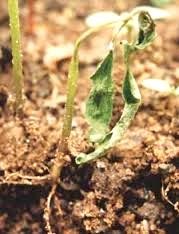 |
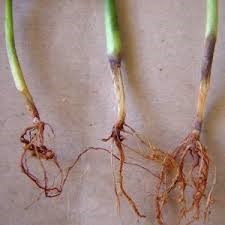 |
- Prepare nursery beds in well drained virgin soil
- Nursery sterilization – burning, solarization or with chemicals
- Remove affected plants with the adjacent soil
- Seed treatment (should be done just before seeding)
- Soil treatment – Drench with a recommended fungicide around the base of the plant as spot application
- Yellowing of leaves
- Decaying near collar region
- Mycelia mat with white / brown Sclerotia on collar region
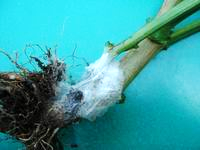 |
- Destroy affected plants with the adjacent soil
- Improve drainage
- Deeply plough the land and expose to affected soil to bright sunlight
- Avoid root damage at transplanting
- Soil treatment – Drench with a recommended fungicide around the base of the plant as spot application
Causal organism: Fusarium oxysporum f.sp lycopersici
Symptoms:
- Yellowing of leaves and wilt
- Vascular discoloration of stem
- Root rot and dying of the plant
Management
- Destroy affected plants with the adjacent soil
- Improve drainage
- Deeply plough the land and expose to affected soil to bright sunlight
- Avoid root damage at transplanting
- Soil treatment – Drench with a recommended fungicide around the base of the plant as spot application
– Thiophanate-methyl 50% WP + Thiram 30% WP – 50g/50l / 10m2
– Thiram 80% WP – 70g/50l / 10m2
– Captan 50% WP – 60g/50l / 10m2
 |
- Circular yellow patches or spots appear on the lower surface of the leaves.
- White powdery residue on the upper leaf surface.
- Use recommended fungicides at initial stage of disease development (Refer: Pesticide recommendation DOA, 2019)
- Apply sulfur 80% WG 50 g/10 l of water
- Chlorothalonil 500g/l SC- 30 ml/10 l of water
- Carbendazim 50% WP- 7 g/10 l of water
- Sunken circular lesions with tan to orange to black concentric rings in their center
- Fruiting bodies with pink masses of conidia may ooze from lesions
 |
 |
- Use of healthy seeds
- Avoid excess overhead irrigation
- Remove and destroy infected fruits
- Seed treatment (should be done just before seeding)
- Foliar application of fungicides start at flowering stage in rainy season
- Small canker gray spots with black margins appear on stem and petioles
- Center of the spot becomes gray and black due to pycnidia development
- Soft and watery fruit spots become black and mummified
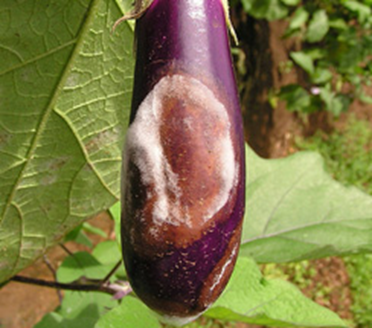 |
- Remove and destruction of infected fruits
- Use recommended fungicides at initial stage of disease development (Refer: Pesticide recommendation DOA, 2019)
- Bacterial diseases
- Slight wilting of single branch/ branches
- Sudden and permanent wilting of entire plant
- Discoloration of the vascular tissues
- Slimy viscous bacterial ooze comes out from the cut end of affected parts when immersed in clear
 |
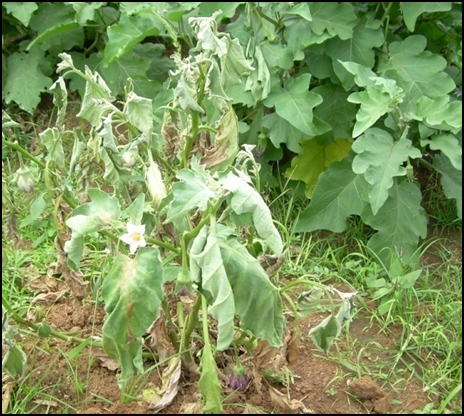 |
- Remove and destroy affected plants with soil
- Destroy crop debris after harvesting
- Crop rotation with non-susceptible crop (cruciferous vegetables and okra) help in reducing the disease incidence
- Use of resistant varieties
- Disinfect all farm implements/tools with bleach after they have been
- No chemical controlling method
- Phytoplasma disease
- leaves are narrow, soft, smooth and yellow
- Internodes of the stem become shorten
- Auxiliary buds get enlarged but their petioles and leaves remain shortened and give the plant a bushy appearance.
- flowers remain green/ no flowering
- Fruiting is rare
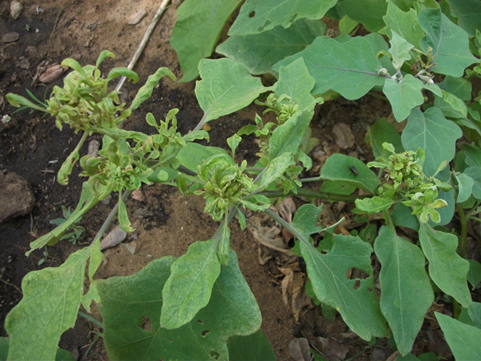 Management
• Remove and burn infected plants.
• Control leaf hopper with recommended insecticides to minimize disease spread.
Management
• Remove and burn infected plants.
• Control leaf hopper with recommended insecticides to minimize disease spread. |
Harvesting
Harvesting can be started 10-12 weeks after transplanting. Fruit can be harvested 7 days intervals up to 10-12 picks.
Yield
Potential yield depends on the variety. OPV gives 18-20 t/ha and hybrids give 30- 40 t/ha
